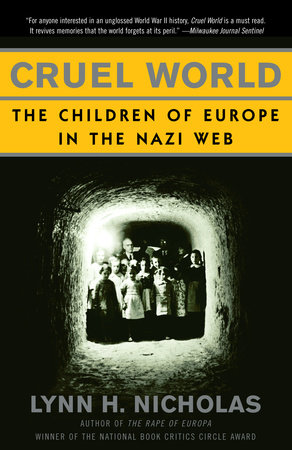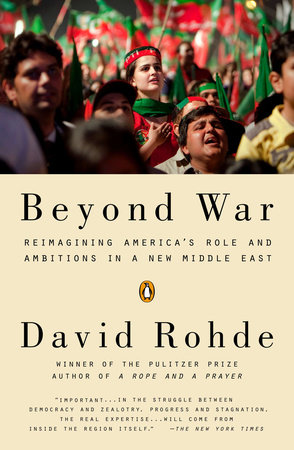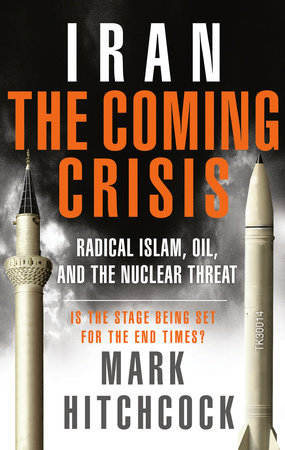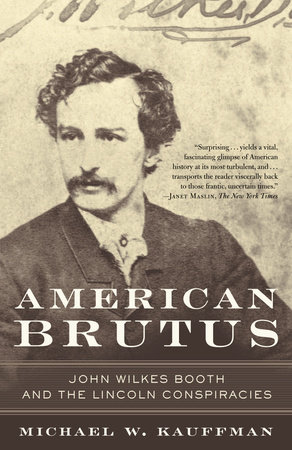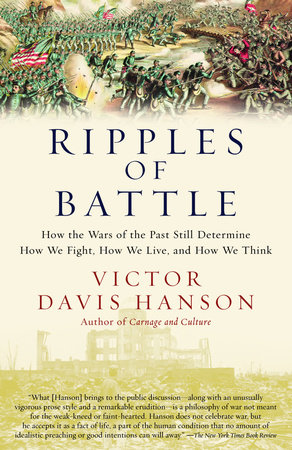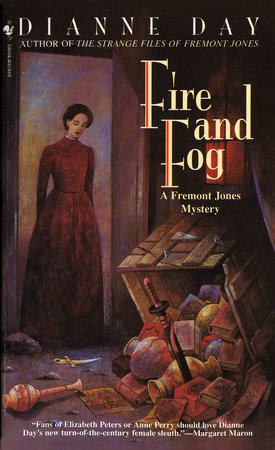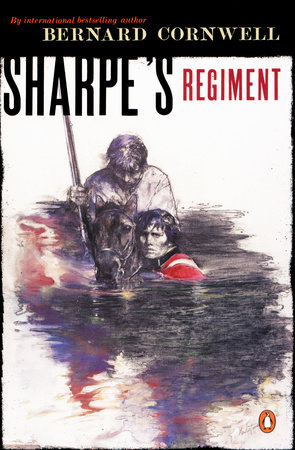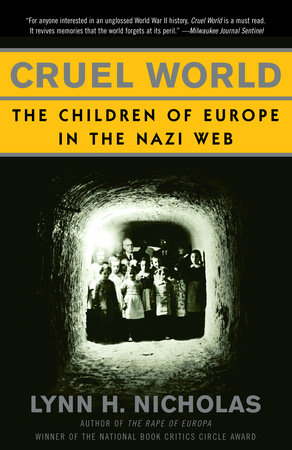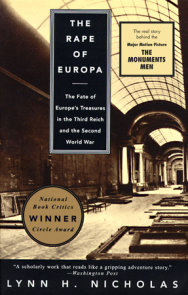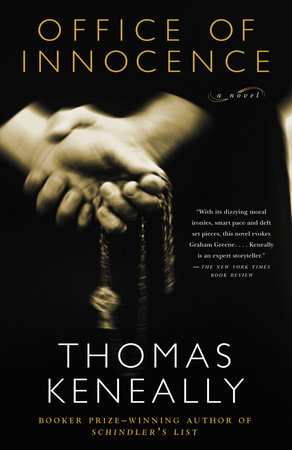Author Q&A
A Conversation with Lynn Nicholas
author of
Cruel World
Q: CRUEL WORLD focuses on the lives and experiences of the children of Europe during and immediately following the Nazi era. Few would remain untouched by the events of that time, and millions of them would be subjected to ferocious indoctrination, torturous deprivation, forced migration, medical experiments, slavery, and murder: What inspired you to write about such a difficult subject?
A: Well, I am myself a child of that era. Some of my earliest memories are of things like wartime blackout curtains and my mother going off work in an air raid warning center in Virginia. I have always been fascinated by the stories European friends of mine told about their lives during World War II. Very soon after the war my father served at the US Embassy in the Netherlands and I saw for myself the bombing damage done to Rotterdam and other places. I did not question at the time the fact that there were people from a number of countries in the Dutch school I attended, but I realize now that they were undoubtedly refugees or displaced persons, as was our housekeeper. During that time (1948-51) we also went to Germany, where the devastation and living conditions and the appearance of the people wandering about, among whom were many war wounded, were truly terrifying. Later I wondered how daily life could continue during full blown war: how families and children coped with destruction of their houses and the lack of food, and what exactly the Nazis did with the children of Germany and the occupied countries and with those of their racial and political enemies.
At college I studied history and specialized in Modern Europe; but at the time I did so the social aspects were not really much emphasized and the courses did not answer these question for me or tell me just how a totalitarian system of government can, so insidiously, overcome a nation accustomed to a democratic one, and dominate even the smallest aspects of daily and family life. As time went on I became more and more interested in the complexity of the Nazi plans for the future of the Third Reich. Most studies of this period, understandably, are rather “vertical” and tend to focus on one particular group or nation. But the Nazi plan was for global domination, and all their agencies, civilian and military, including youth organizations were linked to this international plan, so I have attempted a more “horizontal approach” and tried to compare events taking place simultaneously in different areas. It has certainly been quite a journey of discovery and I have been amazed at some of my findings.
Q: Your first book, The Rape of Europa, also focused on the Second World War. What, initially, brought you to this subject?
A: I think the same impulses led me to The Rape of Europa, but the immediate catalyst there was the death of Rose Valland, a little known Louvre curator, who, the obituary recounted, “had saved thousands of works of art.” This made me curious about what had happened to all the European museums during the war. I had worked off and on in museums for years and therefore knew many of those who had participated in the recovery of works of art. No one had ever asked most of them anything about their extraordinary experiences, which make up most of the second half of The Rape of Europa. But the story of the art could not be told without constant reference to the war in general, and of course to the fate of human beings, and it is that aspect that I address in Cruel World. What is spooky is that the Nazis had the same policies for people as for art: destroy the unacceptable and “degenerate” and gather in and promote the Germanic.
Q: The Rape of Europa inspired an international movement to find and repatriate objects lost and stolen during the Nazi Era and World World II. Do you anticipate any similar reaction to CRUEL WORLD?
A: There could be some revival of the search for missing relations and children, but in fact those searches have never really stopped. It would be wonderful indeed if, due to a bit of information in Cruel World, a family were re-united, but I doubt that will happen. My hope is that this book will make people, in this country especially, aware of the realities of war. We basically, and very fortunately, have no idea of what living in a war zone does to normal human life, but as the only super power we need to know such things. I also hope that the book will serve as a revelation of the damage that results from ideology and tribalism run amok, a problem that is very relevant in today’s world, and still the cause of the deaths of thousands of children.
.
Q: What research was involved in this book? Did you talk to any of the children—now grown—who were subjected to this awful treatment?
A: I did talk to many, many of the “children” who are now mostly grandparents. They include, among others, Russian forced laborers, Germans who were in the Hitler Youth, the children of resisters in many countries, Greek communists, Holocaust survivors, Kindertransport children, Dutch children interned in Japanese camps, “bundles from Britain,” Polish exiles and many more. In addition I talked to numerous members of the agencies that worked with children after the war. It was an astonishing experience. The reactions were very frequently not what I expected—both admirable and unacceptable behavior surfaced in surprising places—and the interviewing process was a good lesson in judging people as individuals and not as members of a labeled entity.
I also, of course, did a great deal of reading and research in the archives of various countries. Washington, DC, where I live, is a gold mine of documentation on this period. At the National Archives, the Library of Congress and the US Holocaust Memorial Museum, in addition to the American and Allied records, there are literally tons of captured German documents. If you have the time and patience, and can read German, the material on Nazi methodology is staggering. In the seven years I took to write this book I could only make a small dent in these documents; but it was enough to produce a devastating picture of their intent.
Q: What was the biggest surprise for you when you were researching the book?
A: I think that there were two main surprises. First, I had not realized how important the concept of Germanization was to the Nazis. Most histories since the war have concentrated on the destructive aspects of the Nazi regime: their conquests of nations and governments and their extermination of “alien races” such as the Jews. Much less coverage, at least in the more popular histories, has been given to the Nazi plans to colonize and Germanize the areas they conquered. This included continued elimination of undesirable races such as the Slavs, the eventual suppression of all religious denominations, and the rescue and “re-Germanization” of those they considered to have sufficient Germanic “blood.” Even at the height of the war they had enormous bureaucracies and enforcement agencies working on these racial matters, all using criteria which were ludicrous, but still deadly. The degree of German blood a child possessed determined his fate: those who were not pure enough could be killed or used as forced labor and were destined for short and miserable lives. The second surprise, or I should say shock, was the fact that the end of the war, which put an end to Nazism, did not put an end to many other long standing ethnic, political and religious hatreds, which indeed seemed to bloom with renewed vigor. Researching the archives of the relief agencies, again and again, one is amazed at the attitudes of organizations and nations and the fact that children, especially, were regarded as a sort of commodity up for grabs to whatever group could get them, often without any reference to their families, who were often searching for them with desperation.
Q: What happened to the approximately 5,000 children of the Lebensborn Societies (pg. 80)? At the time, they were considered “biologically sound,” but after the war, was their background uncovered? Was it a source of shame?
A: The fate of Lebensborn children depended on their nationality. Most German Lebensborn children did remain with their mothers and being illegitimate, might have suffered from that stigma, if the fact were known. Those without parents went to German orphanages and homes. In the chaos of postwar Germany fatherless and completely unidentifiable children were not unusual. In that atmosphere it would not be difficult for a Lebensborn child to escape notice. The fact that most Lebensborn records as well as many municipal records and archives were destroyed, plus the closing off of East Germany made any tracing of children difficult. Generally, I do not believe Lebensborn was an issue in Germany due in part to the great silence there about parental activities in the war. That was not the case in other countries. In Norway, which had the next largest number of Lebensborn babies, the Lebensborn label was shameful. The babies were treated as the children of collaborators, not a good thing. Those in orphanages reportedly were not given the best care, and for many years the Norwegian government refused repatriation of some of the children from Germany or any financial aid to them and their mothers. In Poland, from which thousands of children were kidnapped and sent to Lebensborn schools and institutions, there was no shame attached. There the quest to find and return them lasted for years and produced many extremely emotional situations and conflicts of identity.
Q: In the chapter HITLER’S CHILDREN, you write about the German children who were forced to spend time away from their homes, where old ideas (contrary to the Nazi regime) might reside. The children were essentially brainwashed with the slogan “You were born to die for Germany.” Was this damage reversible?
A: The conquest of the areas contiguous to Germany was an integral part of Hitler’s policies. For this effort, and for its later exploitation he needed large and loyal armies, which meant the young. Every effort was therefore made to turn young people toward nationalism and “defense” of their nation, never mind that it was not actually threatened. This included total allegiance to and worship of the “leader” or Fuhrer, who was, of course Hitler. To attract children, and indeed the whole population, relentless propaganda was used and soon proved the adage that if a lie is repeated often enough by government authorities, people will believe it. In addition, for the young, uniforms and ceremonies with dazzling panoply were the order of the day, as were group activities in which fear of reprisal and peer pressure were knowingly manipulated to replace parental guidance. Just in case there were children who did not follow along, membership in the Hitler Youth was made obligatory for all in 1936. The actual advent of war, in which disinformation was heavily employed to make it appear that Germany had been attacked, brought out the natural patriotic tendencies of youth, who eagerly went forth to defend their homeland. Later on the young were also sent by the thousands to promote the glories of German civilization to the residents of the conquered areas. The constant allied bombing of Germany late in the war seems to have sustained the children’s will to resist. But their dedication was finite. Hitler’s suicide would remove him as an icon. By then the futility and horror of war were obvious to older children. Germany’s defeat and occupation, the revelation of the truths about the regime, and the devastation of the economy, which made pure survival the principal occupation of most families, gave the final blow to the Nazi call to glory. It was also soon clear to most young people that the Allies were not the monsters they had been told to expect. For all but a few hard-core youth leaders adherence to Nazi methods, which had in any case been involuntary for many, did not long outlast Hitler’s demise or the death of his Germany.
Q: Do you equate the treatment of the “good blood” and “bad blood” children to anything happening in our world today?
A: There are many places in the world where “ethnic cleansing” goes on. One has only to think of the former Yugoslavia, Sudan, Rwanda and areas of the Middle and Far East etc. But I have not so far heard of anything that parallels the pseudo-scientific determination of ethnicity used by the Nazis and their passionate efforts to preserve every droplet of “German” blood. I even found a document indicating that they had considered setting up special POW camps for German-American GI’s in which they would attempt to convert them to the Germanic cause!
Q: What’s next for you?
A: Well, I think that World War II, may finally be over for me!! But it is a hard thing to shake as the Nazi phenomenon remains essentially unfathomable and fascinating. And there are still so many more documents I could read!!! But I may go back to earlier times and the art world. We shall see.
